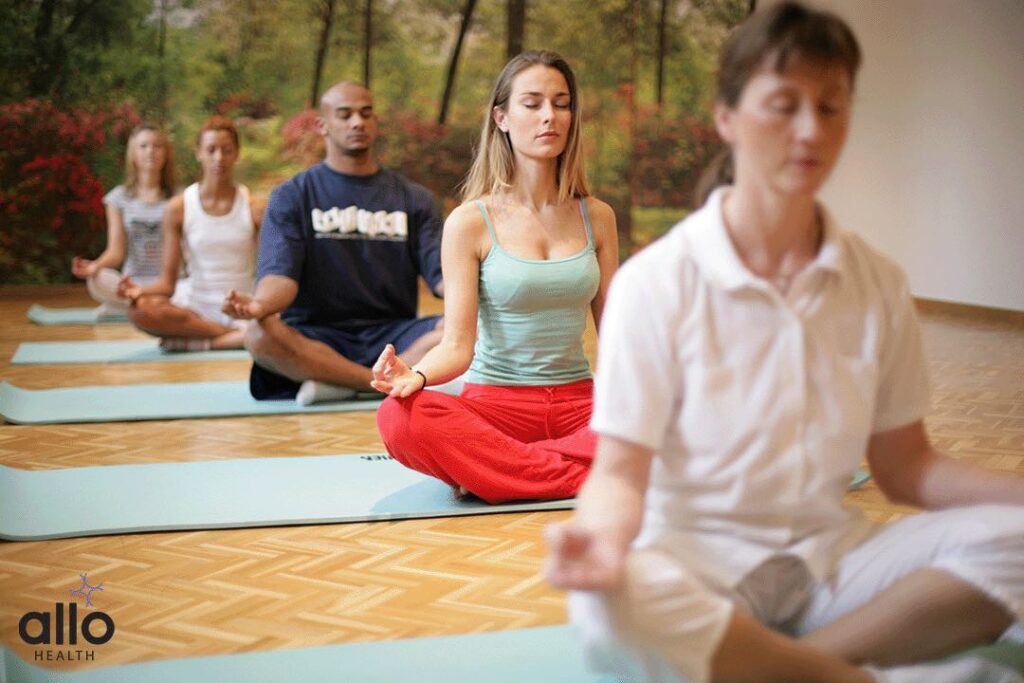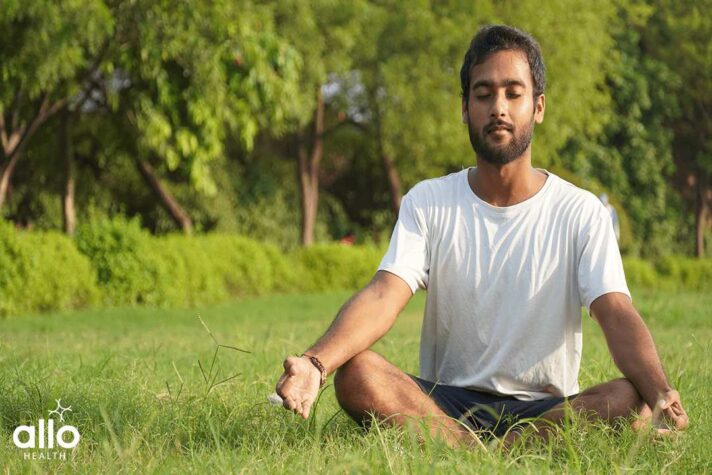Yoga Asanas For Erectile Dysfunction

Allo Health is dedicated to personalized well-being, offering support and trusted information tailored to individual health goals. The platform emphasizes human-generated content, led by a distinguished medical team of experts, including physicians and sexual health specialists. Their commitment to credibility involves rigorous fact-checking, authoritative research, and continuous updates to ensure accurate, up-to-date information. Allo Health's unique approach goes beyond conventional platforms, providing expert-led insights and a continuous commitment to excellence, with user feedback playing a crucial role in shaping the platform's authoritative voice.

Dr. Warisha holds an MBBS degree from GMERS Medical College, Ahmedabad. She has an in depth experience on sexual and reproductive health and rights.
Why This Was Upated?
Our experts continually monitor the health and wellness space, and we update our articles when new information became available.
Updated on 03 November, 2023
- Article was updated as part of our commitment to diversity, equity, and inclusion.

"The following blog article discusses exercise and its potential benefits for general health and well-being. However, it is important to understand that the information provided is for general educational purposes only and should not be considered as personalized exercise advice or a substitute for professional guidance from a qualified fitness professional or healthcare provider. Before starting or modifying any exercise program, it is recommended to consult with a qualified fitness professional.
Book consultation
The information presented in this article may not be suitable for everyone, as individual fitness levels, health conditions, and limitations can vary significantly. A qualified fitness professional can assess your specific fitness needs, consider any medical concerns or limitations, and provide personalized recommendations and exercise plans that are safe and effective for you.
Participating in physical activity, including exercise, carries inherent risks. It is crucial to listen to your body, exercise within your personal limits, and be aware of any signs of discomfort or potential injury. If you experience any pain, dizziness, shortness of breath, or other concerning symptoms during exercise, it is important to stop immediately and seek medical attention if necessary.
The exercises or activities mentioned in this article may not be suitable for individuals with specific medical conditions, injuries, or physical limitations."
Sexual dysfunction or low sex life is the most common concern among couples. Among men, erectile dysfunction is the most common concern, which takes away fun and self-confidence. Thankfully, there are oral medications and other treatments to overcome the concern, but the best is to try natural remedies to solve this concern. Yoga for erectile dysfunction can help to strengthen pelvic muscles further helping to get strong erection and improve your overall health. There are different yoga postures to try out to overcome this concern.
What Is Yoga?
Yoga is an ancient practice that originated in India and has a rich history. It is a holistic approach to achieving balance and harmony in life, encompassing more than just physical exercise. “Yoga” comes from the Sanskrit word “yuj,” meaning to unite or join, symbolizing the integration of body, mind, and spirit.
Yoga encompasses a wide range of practices and philosophies, and it can be challenging to provide an exhaustive overview, but here are some key aspects in detail:
-
Asanas:, or physical postures, are an integral part of yoga. They are practiced to enhance flexibility, strength, balance, and overall physical well-being. Yoga styles such as Hatha, Vinyasa, Ashtanga, and Bikram predominantly emphasize asana practice.
-
Pranayama: also known as breath control, involves conscious control of the breath. The purpose is to regulate the flow of vital energy (prana) in the body through different breathing exercises. Practicing pranayama has benefits such as calming the mind, increasing lung capacity, and enhancing overall well-being.
- Meditation (Dhyana): Meditation is a fundamental aspect of yoga that involves training the mind to focus and concentrate. It encourages self-awareness, mindfulness, and inner peace. Meditation techniques vary, including mindfulness meditation, mantra meditation, and guided imagery.
- Yamas and Niyamas (Ethical and Moral Principles): These are the ethical and moral guidelines that serve as the foundation of yoga philosophy. Yamas include principles like non-violence (ahimsa), truthfulness (satya), and non-greed (aparigraha), while Niyamas include principles like cleanliness (saucha), contentment (santosha), and self-discipline (tapas).
- Dietary Guidelines (Yogic Diet): Yoga places emphasis on maintaining a sattvic (pure) diet, which consists of fresh, whole, and minimally processed foods. A sattvic diet is believed to promote physical health and mental clarity.
- Yoga Philosophy: Yoga is based on philosophical concepts found in texts such as the Yoga Sutras of Patanjali, the Bhagavad Gita, and the Upanishads. These texts explore the nature of the self, the mind, and the universe, offering a framework for comprehending the purpose of life and the path to self-realization.
- Chakras and Energy Centers: In some forms of yoga, practitioners work with the concept of chakras, which are energy centers located along the spine. Balancing these energy centers is believed to promote physical and emotional well-being.
- Kundalini: Kundalini yoga focuses on awakening the dormant spiritual energy, often depicted as a coiled serpent at the base of the spine (kundalini). Through various practices, it aims to raise this energy up through the chakras, leading to spiritual enlightenment.
- Hatha Yoga: Hatha yoga is a branch of yoga that emphasizes physical postures and breath control. It is often used as a foundation for many other yoga styles.
- Karma, Bhakti, and Jnana Yoga: These are three paths of yoga that emphasize different approaches to spiritual growth. Karma yoga is the path of selfless service, Bhakti yoga is the path of devotion and love, and Jnana yoga is the path of knowledge and wisdom.
- Yoga for Health and Well-Being: In modern times, yoga is widely practiced for its physical and mental health benefits. It can help reduce stress, improve flexibility, strengthen muscles, alleviate chronic pain, and promote overall well-being.
- Yoga as a Lifestyle: Many practitioners incorporate yoga principles into their daily lives, promoting mindfulness, compassion, and a sense of interconnectedness with all living beings.
There are numerous styles and variations of yoga, each with its own emphasis and practices. Some people primarily engage in yoga for physical fitness, while others pursue it as a spiritual and philosophical journey. Yoga is highly adaptable and can be customized to suit individual needs and goals. Ultimately, the essence of yoga is the pursuit of self-awareness, inner peace, and the realization of one’s true self.
Health Benefits Of Yoga
Yoga is a holistic practice that has been around for thousands of years and is known for its numerous physical, mental, and emotional health benefits. Here is a detailed overview of the health benefits of yoga:
- Physical Fitness:
- Flexibility: Regular yoga practice can significantly improve flexibility by stretching and lengthening muscles, making it easier to perform various physical activities.
- Strength: Many yoga poses require you to support your body weight, which helps in building and toning muscles.
- Improved Posture: Yoga encourages awareness of body alignment and helps correct poor posture, reducing the risk of musculoskeletal concerns.
- Enhanced Balance and Coordination: Yoga poses often involve balance and coordination, which can improve overall stability and help prevent falls, especially in older individuals.
- Pain Relief:
- Back Pain: Yoga can alleviate chronic lower back pain by strengthening the core and improving spine flexibility.
- Arthritis: Gentle yoga poses can reduce joint pain and stiffness in people with arthritis.
- Migraines: Regular practice may reduce the frequency and intensity of migraines.
- Cardiovascular Health:
- Lower Blood Pressure: Yoga can help lower blood pressure through relaxation techniques and improved circulation.
- Heart Health: Certain yoga practices can reduce the risk of heart disease by improving cholesterol levels and reducing stress.
- Respiratory Benefits:
- Improved Lung Function: Yogic breathing exercises (pranayama) enhance lung capacity, which can be beneficial for individuals with respiratory conditions like asthma.
- Weight Management: While not a high-intensity workout, yoga can aid in weight loss by increasing mindfulness about eating and reducing stress-related overeating.
- Digestive Health: Yoga can promote healthy digestion by massaging and stimulating abdominal organs through various poses.
- Mental and Emotional Well-being:
- Stress Reduction: Yoga reduces the production of stress hormones and activates the relaxation response, leading to decreased stress levels.
- Anxiety and Depression: Regular practice can alleviate symptoms of anxiety and depression by promoting relaxation and mindfulness.
- Improved Sleep: Yoga’s relaxation techniques can help combat insomnia and improve sleep quality.
- Mindfulness and Concentration: Yoga encourages mindfulness, which enhances concentration and cognitive function.
- Pain Management: Individuals with chronic pain conditions, such as fibromyalgia, report reduced pain levels and improved quality of life through yoga.
- Immune System Boost: Some studies suggest that yoga may enhance the immune system’s functioning by reducing inflammation and stress.
- Enhanced Circulation: Yoga poses and stretches improve blood circulation, which can benefit overall health and healing.
- Better Postoperative Recovery: Yoga can aid in recovery after surgery by reducing pain and promoting healing through gentle movements and breathing exercises.
- Self-awareness and Mind-Body Connection: Yoga fosters a deeper understanding of the mind-body connection, helping individuals become more attuned to their physical and emotional needs.
Sexual Health Benefits Of Yoga

Yoga can have several positive effects on sexual health and well-being, both directly and indirectly. Here are some of the sexual health benefits of yoga in detail:
- Improved Blood Flow:
- Yoga poses and stretches can enhance blood circulation throughout the body, including the genital area. This improved circulation can lead to stronger and more sustainable erections in men and heightened arousal in women.
- Stress Reduction:
- Yoga is well-known for its stress-reduction benefits. Reduced stress and anxiety levels can help individuals feel more relaxed and mentally prepared for sexual activity.
- Lower stress levels can also decrease the production of stress hormones, such as cortisol, which can negatively affect sexual desire and performance.
- Enhanced Flexibility and Stamina:
- Yoga can increase overall flexibility, which can be particularly beneficial during sexual activity. Improved flexibility can make it easier to try different sexual positions and movements.
- Increased stamina and endurance gained through yoga can help individuals engage in longer and more satisfying sexual experiences.
- Mind-Body Connection:
- Yoga promotes a strong mind-body connection, which can lead to a greater awareness of physical sensations, including those related to sexual pleasure.
- This heightened awareness can make sexual experiences more enjoyable and satisfying.
- Increased Relaxation:
- Yoga often incorporates relaxation techniques, including deep breathing and meditation. These practices can help individuals relax both physically and mentally, creating a more conducive environment for intimacy.
- Enhanced relaxation can reduce sexual performance anxiety, which is a common concern for many individuals.
- Hormonal Balance:
- Some yoga practices, such as inverted poses, are believed to balance hormones by stimulating the endocrine system. Hormonal balance can contribute to a healthier sex drive and sexual function.
- Pelvic Floor Strength:
- Certain yoga poses and exercises can strengthen the pelvic floor muscles. In women, this can improve vaginal tone and potentially lead to more intense orgasms.
- In men, pelvic floor strength can help with erectile function and ejaculation control.
- Body Confidence:
- Practicing yoga can lead to increased self-confidence and body positivity. Feeling good about one’s body can boost self-esteem and make individuals more comfortable and confident in their sexual relationships.
- Emotional Connection:
- Yoga encourages emotional well-being and mindfulness. This can lead to improved emotional intimacy with a partner, which can enhance overall sexual satisfaction and connection.
- Enhanced Libido:
- By reducing stress and increasing relaxation, yoga can help boost libido, making individuals more interested in and excited about sexual activity.
While Yoga can provide many sexual health benefits, individual experiences may vary. These benefits are often more pronounced with regular and consistent yoga practice. It’s always a good idea to consult with a healthcare provider or a certified yoga instructor before starting a new yoga routine, especially if you have specific sexual health concerns or conditions that need to be addressed.
Can Yoga Help With Erectile Dysfunction
Yoga can be a valuable complementary approach to managing erectile dysfunction (ED), but its effectiveness may vary from person to person. Here’s a detailed explanation of how yoga can potentially help with ED:
- Improved Blood Circulation:
- Yoga poses and stretches can enhance overall blood circulation, including blood flow to the genital area. Improved circulation is essential for achieving and maintaining erections.
- Poses like the Legs Up the Wall pose (Viparita Karani) and the Downward-Facing Dog pose (Adho Mukha Svanasana) can help promote blood flow to the pelvic region.
- Stress Reduction:
- Stress and anxiety are common contributors to ED. Yoga is well-known for its stress-reduction benefits. Regular yoga practice can reduce the production of stress hormones like cortisol, promoting relaxation and a sense of calm.
- Reduced stress levels can lead to improved sexual confidence and performance.
- Pelvic Floor Strengthening:
- Certain yoga exercises, such as pelvic floor exercises (Kegel exercises) and mula bandha (root lock), can strengthen the muscles of the pelvic floor.
- A strong pelvic floor can help with erectile function by improving blood circulation to the genital area and enhancing control over erections.
- Mindfulness and Relaxation:
- Yoga incorporates mindfulness and relaxation techniques, such as deep breathing and meditation. These practices can help individuals become more present and focused during sexual activity, potentially improving their ability to achieve and maintain an erection.
- Hormonal Balance:
- Yoga may stimulate the endocrine system, which can help regulate hormone levels. Hormonal imbalances can sometimes contribute to ED.
- Yoga’s impact on hormones can vary depending on the style of practice and individual factors.
- Enhanced Libido:
- By reducing stress and increasing relaxation, yoga can boost libido, making individuals more interested in and responsive to sexual activity.
- Self-Confidence:
- Practicing yoga can increase self-confidence and body awareness, which can positively impact sexual confidence and self-esteem. Feeling good about one’s body can be beneficial for sexual well-being.
- Holistic Approach:
- Yoga takes a holistic approach to health, addressing physical, mental, and emotional aspects. This comprehensive approach can contribute to overall well-being, which can, in turn, improve sexual health.
Yoga may not be a standalone solution for severe cases of ED, especially if there are underlying medical concerns. It is essential to consult with a healthcare provider if you are experiencing persistent erectile difficulties, as there can be various causes, including medical conditions, medications, or psychological factors.
Incorporating yoga into a broader approach to ED management, which may include medical treatments or lifestyle changes, can be a helpful strategy. Working with a certified yoga instructor or therapist experienced in sexual health concerns can also provide personalized guidance and support.
Yoga For Erectile Dysfunction
Yoga can be a complementary approach to managing erectile dysfunction (ED) by addressing both physical and psychological aspects of the condition. Here’s a detailed explanation of how yoga can be used specifically for ED:
- Pelvic Floor Exercises:
- Pelvic floor exercises, often referred to as Kegel exercises, are a key component of yoga for ED. These exercises strengthen the pelvic floor muscles, which play a crucial role in achieving and maintaining an erection.
- To perform Kegel exercises, contract and hold the muscles that you use to stop the flow of urine for a few seconds, then release. Repeat this several times in a row.
- A strong pelvic floor can improve blood flow to the genital area and enhance erectile function.
- Deep Breathing and Relaxation:
- Yoga emphasizes deep, diaphragmatic breathing and relaxation techniques. Stress and anxiety are common causes of ED, and these techniques can help reduce these factors.
- Deep breathing and relaxation can calm the nervous system, reducing the production of stress hormones and promoting a sense of calm and well-being.
- Specific Yoga Poses:
- Certain yoga poses can be particularly beneficial for ED by improving blood circulation and reducing stress. These poses include:
- Legs Up the Wall Pose (Viparita Karani): This pose promotes blood flow to the pelvic region and can help relieve stress.
- Bridge Pose (Setu Bandha Sarvangasana): It strengthens the pelvic muscles and stimulates the thyroid gland, which can contribute to hormonal balance.
- Cobra Pose (Bhujangasana): This pose can improve flexibility in the spine and promote blood circulation.
- Regular practice of these poses may help alleviate symptoms of ED over time.
- Certain yoga poses can be particularly beneficial for ED by improving blood circulation and reducing stress. These poses include:
- Mindfulness Meditation:
- Mindfulness meditation, which is often incorporated into yoga practice, can increase awareness and focus. This heightened awareness can translate to improved sexual performance by allowing individuals to be more present during sexual activity.
- Hormonal Balance:
- Some yoga practices, particularly inverted poses, are believed to stimulate the endocrine system. This can help regulate hormone levels, potentially addressing hormonal imbalances that contribute to ED.
- Lifestyle Changes:
- Yoga often encourages a healthy lifestyle, including a balanced diet and regular exercise. Maintaining a healthy weight and overall wellness can positively impact sexual health.
- Psychological Benefits:
- Yoga can improve mental health by reducing symptoms of depression and anxiety, both of which can contribute to ED.
- Enhanced self-confidence and body image can also improve sexual confidence.
- Consultation with a Yoga Instructor:
- It’s advisable to work with a certified yoga instructor experienced in addressing sexual health concerns or to consult with a healthcare professional before beginning a specific yoga regimen for ED. They can provide guidance tailored to your individual needs.
While yoga can be a helpful part of an ED management plan, it may not provide immediate results, and its effectiveness can vary among individuals. For severe or persistent cases of ED, it’s essential to consult with a healthcare provider who can explore potential underlying medical causes and recommend appropriate treatments or therapies in addition to yoga.
Frequently Asked Questions
(1) Can yoga really help with erectile dysfunction (ED)?
Yoga can be a beneficial part of a holistic approach to managing ED. It helps improve blood circulation, reduces stress, and strengthens pelvic muscles, potentially enhancing erectile function.
(2) How often should I practice yoga to see results for ED?
Regular practice is key. Aim for at least 3-4 sessions per week, but consistency over time matters more than frequency.
(3) Are there specific yoga poses that work best for ED?
Poses like Legs Up the Wall, Bridge, and Cobra can be helpful. Focus on poses that improve circulation, flexibility, and pelvic strength.
(4) Can yoga replace medical treatments for ED?
Yoga can complement medical treatments but may not replace them for severe cases. Consult a healthcare provider for personalized advice.
(5) Can yoga improve sexual confidence?
Yes, yoga can enhance self-confidence and body image, which can positively impact sexual confidence and performance.
(6) Are there any side effects to using yoga for ED?
Yoga is generally safe. Consult a healthcare professional if you have specific concerns or medical conditions.
(7) Can women also benefit from yoga for sexual health?
Absolutely, women can benefit from yoga for pelvic floor strength, improved blood flow, and enhanced sexual well-being.
(8) How long does it take to see improvements with yoga for ED?
Results vary, but some individuals may notice improvements within a few weeks to months with consistent practice.
(9) Are there specific breathing exercises that help with ED?
Deep, diaphragmatic breathing and mindfulness meditation can reduce stress and anxiety, which often contribute to ED.
(10) Can older individuals benefit from yoga for ED?
Yes, yoga is suitable for people of all ages. It can be especially helpful for older individuals in maintaining sexual function and overall well-being.





































